April 10, 2018

Japanese beetles, soybean cyst nematode, slugs, sudden death syndrome, white mold, gray leaf spot, stink bugs and a few other corn and soybean pests caused issues during 2017, according to reports from WinField United agronomists in eight Midwest states.
As you prepare for 2018, here is advice on warding off some of the biggest issues from 2017 according to Winfield United agronomists, as well as state-by-state reports from their boots-on-the-ground assessment.
To check out what Winfield United Agronomists found in the fields by state, check out the breakdown here.
Leaf diseases:
Farmers who expected disease pressures from fusarium, southern rust, common rust, gray leaf spot and others applied groups 3, 7 and 11 fungicides prior to diseases setting up shop and again after disease was found in other fields, says Illinois agronomist Sara Smelser. She says farmers looking for late-season plant health benefits applied a strobilurin fungicide on corn at R1.
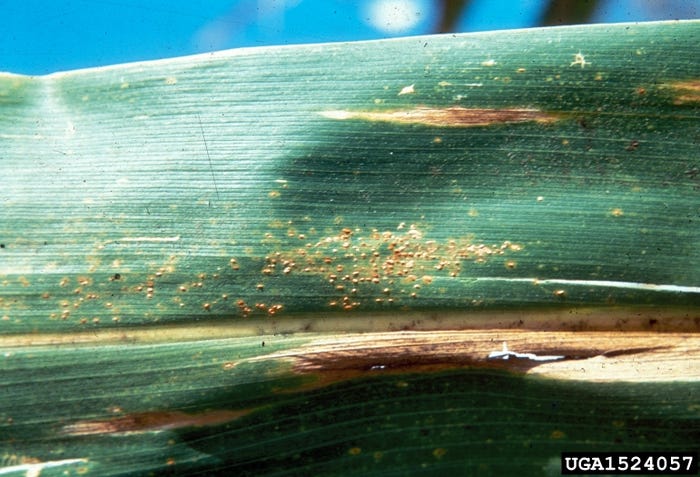
When formulating this year’s disease management plan, Smelser says there are two types of products farmers should keep in mind. Answer Plot data showed fungicide applications had a positive return on investment in corn at VT/R1 with products containing a strobilurin fungicide. In addition, products containing a group 7 succinate dehydrogenase inhibitor (SDHI) showed improved performance over those not containing an SDHI.
Indiana agronomist Glenn Longabaugh says it’s best to use a premium seed with a fungicide package to control these diseases. Farmers should also delay planting if the weather forecast shows above-average rainfall and below-normal temperatures. He cautions not to plant ahead of a bad forecast. Ideally, the corn seed should have at least three warm days in the ground before facing suboptimal weather conditions.
Longabaugh offers farmers this advice going into the new season: “One, remember that fungicides often pay even when there isn’t a disease epidemic. And two, significantly increasing yield rarely happens from making a single amendment; rather, it is more likely to occur by creating synergies across a range of agronomic decisions. Not every farmer can be a contest winner, but every farmer should have a pet field that they treat like one,” he notes.
Fusarium stalk rot:
The disease tends to set up early in the season and nibble away at the stalk, resulting in poor stalk quality at the end of the season. If a windstorm blows through, farmers will get a lot of downed corn, says Michigan agronomist Jason Roth.
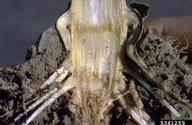
Roth recommends prioritizing fields for harvest based on stalk endurance. To do this, farmers can perform a pinch test, where they squeeze the stalk between the two nodes that are about 6 inches off the ground. If the stalk crumbles, is spongy and bends, it does not have good integrity.
In another test, the farmer pushes the corn plant to about a 30-degree angle. If it pops back after being released, that stalk has good integrity. If it bends and starts to fall over, there are integrity issues. It’s not always convenient to harvest fields out of the order the farmer had planned, says Roth, but sometimes it’s necessary in order to get plants with weak stalks out of the field first.
CORN INSECTS
Corn Rootworm:
Smelser observed this past summer that corn hybrids with the SmartStax trait package maintained better rootworm control than some other hybrids. Acres not treated with in-furrow insecticides also couldn’t stand up to rootworm pressure, she adds.
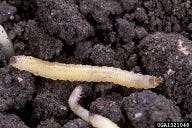
To get a sense of corn rootworm pressure, Wisconsin agronomist Jon Zuk performed a number of corn rootworm floats in 2017. This required taking a 7-inch-by-7-inch root mass sample, including dirt; submerging it in a 5-gallon bucket of water; and counting the number of worms that floated to the top in order to gauge larvae feeding pressure within various fields. Farmers can work with their agronomists to perform this same test.
And, though a corn rootworm float is a good tool, Zuk says it is even more important to choose corn rootworm-traited seed and to apply insecticides at planting to manage corn rootworms. It’s essential for farmers to address insect pressures when they are planning and while they are planting. Pressures can be managed through crop rotation, traited hybrids and timely insecticide applications.
Japanese beetles:
Japanese beetles threaten corn yields because they often feed on corn silks, Iowa agronomist Tyler Steinkamp says. If Japanese beetles clip silks during the crop’s crucial 10-day pollination window, pollination won’t be as successful, and farmers can see dramatic yield losses. Japanese beetles can also open up the ears, leading to secondary insects and ear diseases.
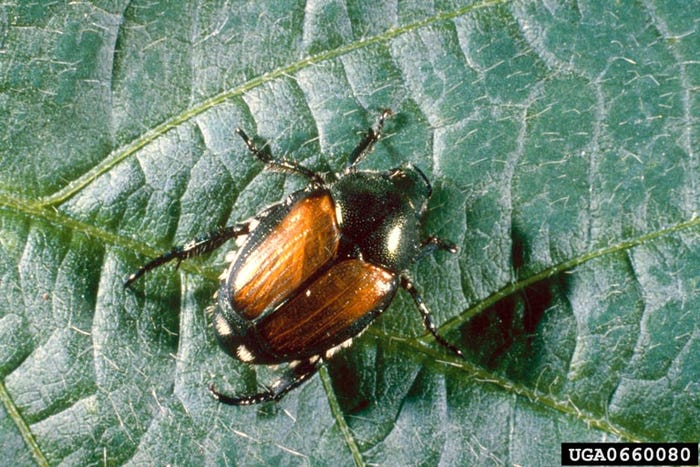
Japanese beetle larvae feed off the roots of grass plants and cover crops, so it’s important for farmers with cover crops to watch for beetle pressure. Once the larvae becomes a beetle, it only lives for 30 to 40 days. However, during that time it can cause significant crop damage. In 2018, Steinkamp advises farmers to pay attention to growing degree days. Japanese beetles need about 1,030 growing degree days to complete development and will continue to emerge until around 2,150 degree days, making this an important scouting time for farmers.
Japanese beetles can be tough to control. Steinkamp recommends using products with a quick knockdown. He also cautions farmers to pay attention to residual. Residual control of these products might not be as long as farmers are used to because they are used to thinking about residual control with insecticides for aphids. Aphids are not very mobile, so they don’t re-infect fields quickly when residual wears off. However, Japanese beetles are much more mobile, so residual control won’t last as long. Farmers should be continually scouting, even after making an insecticide application.
Steinkamp also recommends using products with good coverage, as Japanese beetles also feed lower on plants. Using an adjuvant can help drive spray deeper into the canopy.
Western bean cutworm:
Western bean cutworm is problematic in that farmers don’t always know where it’s going to be, and there are few effective trait options for management. The best plan to control western bean cutworm is vigilant scouting, says Michigan agronomist Jason Roth. The optimal time to scout is just prior to tassel because the insect lays its eggs at the top of the leaf and into the upper canopy. The downside of that is that no one wants to walk through tall cornfields in late June and into July. Aerially applied insecticides can be effective, but timing is important — once the western bean cutworm gets into the ear, an insecticide is not going to help. Plus, when the pest infiltrates the plant, an entry point for disease, including fusarium ear rot is created.
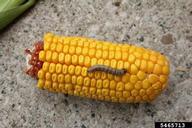
Farmers can’t do much during the off-season to prepare for western bean cutworm, but Roth recommends that farmers who have had problems with them in the past should look for traited seed that provides above-ground protection against this pest. In any case, they should be prepared to scout and apply an insecticide if they see a lot of western bean cutworm egg masses.
SOYBEAN DISEASES
White mold:
Minnesota agronomist Mark Glady says a number of farmers used two fungicide applications to help control white mold and minimize yield loss in 2017. Farmers who sprayed a Group 14 herbicide (PPO inhibitor), specifically Cobra, at first flower significantly reduced the amount of white mold in their fields, Glady notes.
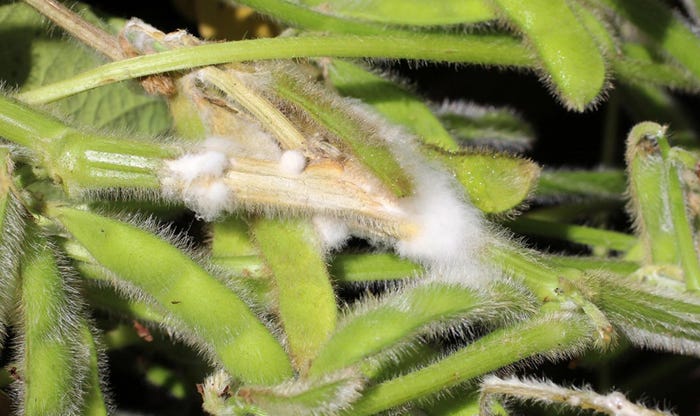
To help manage soybean white mold in 2018, Glady recommends the following:
1. Select a variety with a high tolerance to white mold.
2. Rotate out of soybeans to grass crops such as corn or wheat, or to any non-host crop for white mold.
3. Apply a fungicide or Cobra to help minimize the disease at R1 (first flower).
In Wisconsin, white mold was seen in some soybeans. Agronomist Jon Zuk says the best thing farmers can do to prevent it is to select the right variety. It’s better to choose the right seed than to spend money on a product that won’t eliminate the problem. In terms of fungicides for white mold, get out and spray early (before flowering) if you want to see any results.
Sudden Death Syndrome:
SDS is a fusarium fungus species, so it survives in the soil and can return year after year. Many of the fields that experienced SDS pressure in 2016 will experience it again in 2018, when fields that rotated to corn move back to soybeans, says Steinkamp.
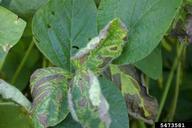
SDS is a root rot pathogen, so it moves quickly into the root of the plant. This disease affects soybeans shortly after planting, as the plant begins to emerge. Often, farmers think of the above ground symptoms present with SDS. However, since the disease lives in the root of the plant, foliar fungicides have no effect on the SDS pathogen.
Most SDS pressure can be found in poorly drained, heavy soils with high pH levels. Additionally, the disease is closely tied to soybean cyst nematode (SCN). If farmers have high counts of SCN, they can probably expect that SDS or a similar fusarium species is present in the soil.
With SDS, yield loss depends on when symptoms begin to show. If conditions are right, symptoms may not appear at all and farmers will not experience yield loss. However, if adverse conditions present themselves (especially in August), symptoms appear quickly and can lead to yield loss.
The best way to reduce the chance of SDS is to choose soybean seed varieties carefully. Farmers should speak with their retailers to find the SDS tolerance that is appropriate for their fields. Some seed treatments have also been proven effective against the fusarium species that causes SDS.
SOYBEAN INSECTS
Scouting and identifying the economic threshold are important in gauging pest pressure, but Indiana agronomist Glenn Longabaugh says to proceed with caution. Rarely do soybean fields only harbor one type of insect, and the economic threshold varies by pest. It almost always pays for farmers to make an insecticide application while they’re making a fungicide application on soybeans to generate the response.
Japanese beetles:
In soybean fields, Japanese beetles can defoliate plants quickly, which diminishes the plant’s photosynthetic capacity, says Iowa agronomist Tyler Steinkamp. Soybeans can typically handle a significant amount of defoliation without much yield loss if the defoliation occurs before flowering. However, if the plant is defoliated after flowering, yield loss occurs much faster.
Soil and plant health
Going into 2018, Roth says that in-season nutrient management is key to achieving good soil and plant health. Think through your nitrogen management strategically. Using a nitrogen stabilizer or splitting applications can help promote nitrogen efficacy and overall crop health. Don’t forget about potassium, which also affects crop health and stalk strength. Healthy soil can help stave off diseases like stalk rot from taking over the plant. Doing a soil test in the spring can give you the data you need to get your nutrient management strategy in order for 2018. Another option may be to consider a fungicide application in 2018. Fungicides can aid in helping stalk strength by both increasing stay green and reducing respiration rates. Both of these increase the amount of photosynthate available to the ear and potentially decrease stalk cannibalization for ear fill.
To get more details on what Winfield United Agronomists found in the fields in 2017 by state, check out the break down here.
About the Author(s)
You May Also Like






